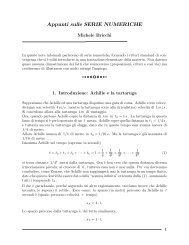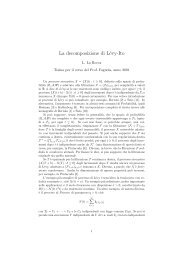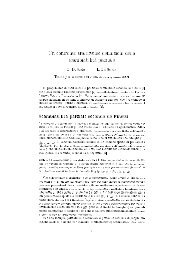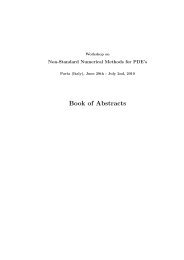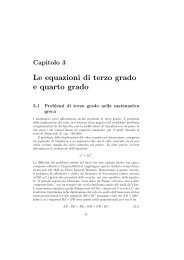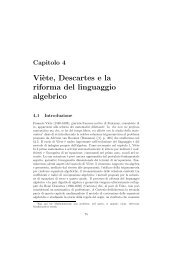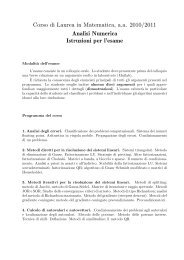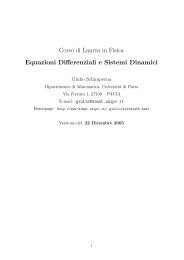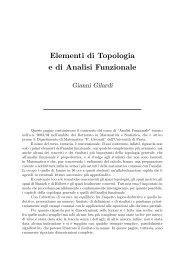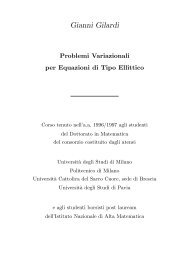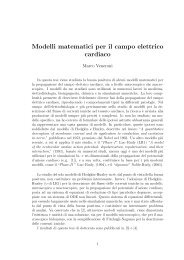Capitolo II - Dipartimento di Matematica
Capitolo II - Dipartimento di Matematica
Capitolo II - Dipartimento di Matematica
You also want an ePaper? Increase the reach of your titles
YUMPU automatically turns print PDFs into web optimized ePapers that Google loves.
24 CAPITOLO 2. MENO PER MENO FA PIÙ<br />
By the definitions, +a − a = 0; therefore, if we multiply +a − a by n, the<br />
Product must vanish or be 0, because the Factor a − a is 0. The first term of<br />
the Product is +na (by Case I.) Therefore the second Term of the Product must<br />
be −na which destroys +na; so that the whole Product must be +na−na = 0.<br />
Therefore, −a multiplied by +n gives −na. ([12], p. 13)<br />
MacLaurin dà per scontata la proprietà <strong>di</strong>stributiva e pone in evidenza il<br />
ruolo privilegiato dello 0 rispetto all’ad<strong>di</strong>zione.<br />
Case <strong>II</strong>I. Multiplication by a positive Number implies a repeated Ad<strong>di</strong>tion:<br />
But Multiplication by a Negative implies a repeated Subtraction. And when +a<br />
is to be multiplied by −n, the Meaning is that +a is to be subtracted as often as<br />
there are Units in n: Therefore the Product is negative, being −na.<br />
MacLaurin non si riferisce come altri, implicitamente, alla proprietà commutativa<br />
del prodotto ma interpreta la moltiplicazione per −n come sottrazione<br />
ripetuta, anziché come ad<strong>di</strong>zione ripetuta. Infine, il caso IV, il più spinoso:<br />
Case IV. when −a is to be multiplied by −n, then −a is to be subtracted as<br />
often as there are Units in n; but (by §10) to subtract −a is equivalent to ad<strong>di</strong>ng<br />
+a, consequently the Product is +na. ([12], p. 13)<br />
Anche qui Mc Laurin aggiunge un’illustrazione della regola<br />
If we multiply +a−a by −n, the first Term of the Product being −na, the<br />
latter Term of the product must be +na, because the two together must destroy<br />
each other, or their Amount be 0, since one of the factors (viz. a − a) is 0.<br />
Therefore −a multiplied by −n must give +na. ([12], p. 13).<br />
Il ruolo dello privilegiato dello 0 emerge in altri due approcci: quello contenuto<br />
nelle Institutiones Analyticae <strong>di</strong> Vincenzo Riccati e Gerolamo Sala<strong>di</strong>ni<br />
[19], pubblicato nel 1765 e quello presente nei The elements of Algebra in Ten<br />
Books <strong>di</strong> Nicholas Saunderson, pubblicato nel 1790.<br />
Vincenzo Riccati e l’allievo Gerolamo Sala<strong>di</strong>ni, dopo aver utilizzato l’analogia<br />
cinematica del verso <strong>di</strong> percorrenza per <strong>di</strong>stinguere tra quantità positive e<br />
negative, illustrano la regola dei segni in questi termini:<br />
Siccome il moltiplicatore altro non mostra che il numero <strong>di</strong> volte in cui bisogna<br />
prendere la quantità da moltiplicare, se entrambi sono positivi, lo sarà<br />
evidentemente anche il prodotto e lo sarà tanto <strong>di</strong> più quanto più grande è il<br />
moltiplicatore, e tanto meno quanto minore è il moltiplicatore; pertanto, se il<br />
moltiplicatore è zero, lo sarà anche il prodotto. Quin<strong>di</strong> se il moltiplicatore decresce<br />
<strong>di</strong> più, al punto da <strong>di</strong>ventare negativo, cioè minore <strong>di</strong> zero, occorre che anche<br />
il prodotto decresca <strong>di</strong> più e <strong>di</strong>venti dunque minore <strong>di</strong> zero, cioè negativo. Ecco<br />
dunque in che modo è evidente che il prodotto <strong>di</strong> una quantità positiva per una<br />
negativa sia negativo. Supponiamo ora che occorra moltiplicare una quantità<br />
negativa per una positiva. Da quanto <strong>di</strong>mostrato, il prodotto sarà negativo e lo<br />
sarà tanto <strong>di</strong> meno in quest’or<strong>di</strong>ne, cioè tanto più minore <strong>di</strong> 0 quanto più cresce<br />
il moltiplicatore, o <strong>di</strong>venta maggiore, e quanto più piccolo sarà il moltiplicatore,<br />
tanto più il prodotto sarà minore nell’or<strong>di</strong>ne delle quantità negative, cioè più<br />
vicino allo zero; cosicché il prodotto cresce sempre se il moltiplicatore decresce:<br />
pertanto, quando quest’ultimo è zero, il prodotto sarà zero: pertanto se il moltiplicatore<br />
<strong>di</strong>minuisce ancora, cioè se <strong>di</strong>venta negativo, il prodotto crescerà <strong>di</strong> più<br />
e quin<strong>di</strong> <strong>di</strong>verrà maggiore <strong>di</strong> zero, e <strong>di</strong> conseguenza positivo; pertanto una quan-



